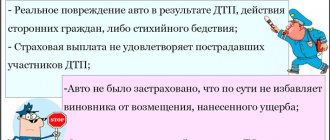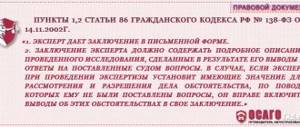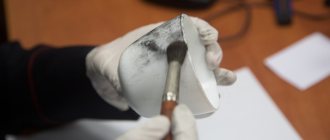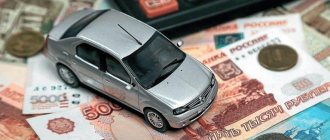A traffic accident is an extremely unpleasant and very costly incident. After it, at least repair of the damaged vehicle is always required. And very often the insurance company seeks to underestimate the damage to the car in order to pay the victim less money. You can protect yourself from such arbitrariness. To do this, an independent examination of the car after an accident will be required.
What is an independent examination after an accident?
When an accident occurs, the driver first dials two numbers - these are the telephone numbers of the traffic police and his insurance company. The following actions take place right there on the spot:
- Determination of the culprit of the accident. This is necessary, since it is his insurer who will calculate the damage caused and issue the amount. Sometimes drivers insist on conducting a trace examination, since no one considers themselves to be in the wrong.
- Description of damage received by the vehicle. This is what the insurance agent does.
- An accident notification is issued.
If the damage cannot be assessed on site, the car will be sent to a service station owned by the insurance company. There, the damaged car is carefully examined for damage and the insurance company issues a final verdict on the cost of repairs.
Automotive technical examination in case of road accidents. Is it possible to challenge an auto technical examination? Read here.
Find out more about automotive technical expertise at the following link:
So what is it? This is an examination of the car, which is carried out by a disinterested person - that is, not a representative of either the insurance company or the victim.
Important! The expert should not be subject to any pressure from one side or another. Therefore, it is advisable not to settle for the companies provided by insurers, but to search on your own.
Similar damage assessments are carried out by special companies that are not related to the insurance company. The bureau for assessing the condition of the car after an accident must be chosen very carefully; attention should be paid to the following criteria:
- experience;
- availability of bureau liability insurance;
- entry of the bureau or its employees into the SRO of appraisers.
Stages of examination
The place and time of the inspection is specified in the contract. This can be an area rented by the appraisal company, or an area chosen by the client.
There is no need to repair the car until an official conclusion is received. Theoretically, according to the law, the insurance company cannot refuse payment if restoration has been carried out, but does not interfere with the assessment of damage and determination of the insured event. However, unnecessary hassle and disputes cannot be avoided. It’s even better not to restore the car until you receive compensation: if errors are found in the previous report, you will have to re-inspect it.
Stages of the examination:
- inspection and photographic recording of vehicle damage with a description;
- analysis of the spare parts market for a given car (taking into account wear and tear);
- calculation of the cost of repairs, including the price of services, purchase of spare parts, necessary materials;
- drawing up an expert report describing the examination process and conclusions.
The customer must be present during the vehicle inspection. It is also necessary to invite a representative of the Investigative Committee (his presence is optional).
The expert opinion must be certified by the signature of a specialist and the seal of the organization conducting the assessment. This document must first be submitted to the insurance company. If she does not compensate for the damage within 20 days, she will have to go to court with a civil claim.
Why is an independent examination needed?
An independent examination after an accident (car examination) has the goal of setting a real price for repairing the damaged car, not underestimated by the company to reduce its costs and not inflated by the victim to increase its profits. Since underestimating the cost of insurance damage is a common practice, there is an urgent need for outside specialists.
Another problem is when to do an independent examination after an accident? You need to know that it is carried out either immediately after the accident, if the victim wants it, or after the insurers have rendered a verdict, if the price they set seems too low. An assessment of damage by a third-party company will force the insurance company to pay the amount in full either voluntarily or in court.
Carrying out this examination can protect the victim from unnecessary financial expenses. But this will take time. Most often, the victim waits five days until the insurer makes a decision, and only then contacts the appraisal company. The timing of an independent examination after an accident already varies depending on the degree of damage to the vehicle. But on average this period is two to three days. And only after this the driver will be able to receive the actual price for the repair, which he will transfer to the insurance company. There, the verdict of an independent appraiser will be considered for a maximum of ten days.
The need for independent auto examination. Pros for the car owner, cons for the insurance company
Get a discount coupon
Fill out the telegram form
Road accident Step by step
Road traffic accidents are a fairly common nuisance in the modern world. There are many reasons for this - traffic congestion, the general psycho-emotional fatigue of drivers, and the low level of preparedness of drivers for the realities of various transport situations. So no one is protected from an accident, the only question is the consequences. And if the health outcome of the incident does not depend on us, as well as the complexity of the accident, then the consequences for the car can be corrected if you approach the issue correctly, insure yourself in advance, and immediately after the accident turn to a service such as an independent auto examination.
There are many opinions about the need for independent expertise. The number of supporters and opponents is approximately equal. But we will not join any camp without arguments and will comprehensively consider such a concept as an independent examination after an accident, the purpose of which is to assess damage from an accident.
Let's consider when it is still useful to conduct an independent auto examination after a traffic accident. There are a number of situations in which an independent auto examination will be a very wise decision. For example, a car owner may oppose such a decision as constructive loss of the car. Or, in the opinion of the car owner, the amount of insurance payments after the car was in an accident is too small. Also, sometimes a car owner may suspect that the insurance company deliberately underestimates damage in order to minimize insurance payments. It is worth noting that this situation is not uncommon in the insurance market. And sometimes such decisions are made even by respected insurance companies - after all, the participants in the process are ordinary people, who sometimes, for the sake of personal gain or career growth, make decisions that are not entirely beneficial for the owner of a car damaged in a traffic accident.
Quite often, after the occurrence of a traffic accident, representatives and agents of the insurance company actively advise making an independent, as they say, examination of the proposed companies. Car owners should never agree to such interesting offers. And let such helpfulness not lead to doubts - in this case, representatives of the insurance company are not at all willing to help the car owner, telling him the contacts of the “correct” appraisal companies. Most often, there is a conspiracy between such a company, which carries out the process of independent auto examination and assesses damage from an accident, and the insurance company. And the assessment of damage from an accident will be fully agreed with the agents of the insurance company, which naturally will be disadvantageous for the car owner. But such mistakes by car owners significantly save insurance companies money. The essence of the conspiracy is simple - the insurance company provides a large volume of orders for the appraisal firm, and this firm, in turn, evaluates damage from an accident in a way that is beneficial to the insurance company. Everyone is happy, everyone is fine. But the owner of the car will simply be deceived and will receive less insurance payments by a significant amount. This practice is quite popular now. This is the first significant advantage of a truly independent auto examination - thereby the car owner protects himself from dishonest appraisers and does not allow the insurance company to deceive himself.
And do not listen to representatives of the insurance company if they convince you that you can only contact those companies that are approved in the instructions of the insurance company. It is worth knowing that, according to paragraph number forty-five of the government decree of the Russian Federation dated August 28, 2006, number five hundred and twenty-five, the car owner should not send the car for inspection only at the direction of the insurance company. The car owner has the right to contact the appraisal company of his choice and order an independent auto examination there. Moreover, this can be done almost immediately after an accident and without waiting a certain number of days, as representatives of the insurance company like to convince.
Moreover, the insurance company is simply obliged to accept independent expert reports, and then use the obtained data in assessing damage from an accident. So the calculation of compensation payments will have to be based on the figures in the submitted documents. If everything happens this way, then you can be sure that the damage is assessed correctly without any deliberate underestimation. Moreover, the cost of an independent auto examination is also reimbursed by the insurance company.
It is not difficult to guess that it is extremely unprofitable for insurance companies for car owners to turn to independent firms for an assessment of damage from an accident - because then the insurer has to pay the full cost of damage to the car without any clever tricks with numbers. And therefore, quite often, representatives of the insurance company dispute the conclusions of an independent auto expert examination, and even delay payments. In such cases, it is necessary to immediately go to court - this is the practice that best motivates insurance companies to behave honestly and openly. Pre-trial appeal to the insurance supervision service and the Russian Union of Auto Insurers also has a positive effect on insurance companies. Unfortunately, honesty and loyalty are not the strong points of most insurance companies. So the car owner sometimes has to put a lot of pressure on the insurance company so that it honestly and in full pays all the funds due. Quite often, a situation arises when the car owner clearly sees that the assessment of damage from an accident does not correspond to reality at all, and the insurance company itself has engaged an expert firm to carry out an independent examination. In this case, a wise and correct decision would be to start a counter-examination by contacting an independent appraiser. If the results of these two examinations differ greatly, then you can challenge the decision of the insurance company and their appraiser in pre-trial or court proceedings.
As you can see, assessing damage from an accident using a process such as an independent examination is very important after an accident - only such a procedure can guarantee that the insurance company will deal fairly with the car owner and make all necessary payments.
Types of independent examinations
Often, when a car is damaged, you cannot limit yourself to just estimating the cost of repairing the car. It may be necessary to carry out additional checks. An independent examination of damage after an accident can also be:
- Traceological - analysis of the accident site. Tire tracks are inspected, vehicle trajectories are analyzed and the traffic situation is assessed. This study will establish why the accident occurred and who is to blame.
- Automotive - research of the condition of cars. It also studies how the driver acted during the accident, how the car behaved on the road before the collision. Helps determine who caused the accident.
- Automotive merchandising - examines the condition of vehicles after a collision. Detects all defects, both internal and external. Estimates the amount of damage received and the cost required for repairs. Essentially, an independent examination of a vehicle after an accident.
- Comprehensive - all the above checks together. This is necessary in order to most fully assess what happened on the road and reconstruct all the events.
Why is expertise needed?
The culprit of the accident will have to restore his car at his own expense if he does not have a comprehensive insurance policy. But the victim is entitled to compensation for damages under compulsory motor liability insurance.
However, motorists do not always receive full compensation. Insurers are trying in every way to save money and reduce the amount of compensation, using various tricks and schemes.
In some cases, the situation is complicated by the fact that no one pleads guilty in the collision, each participant in the accident gives his own testimony, different from the other, and there are no witnesses to what happened.
An independent examination of a car after an accident is indispensable here..
It will help not only to identify all the damage, but also to understand who is really to blame for what happened.
The expert’s task is to study the condition of the vehicle, describe defects, compare facts (speed of each car, location after a collision, etc.).
The results are reflected in an officially compiled report, which is issued to the customer. It indicates the total amount of damage and describes the main points of what happened.
If necessary, the market value of the vehicle can be established.
The use of independent expert services guarantees you an objective assessment of the damage caused. Firms recommended by the insurer may be in close relationship with him and, in the interests of the partner, underestimate the true amount of the loss.
If, at the direction of the insurer, you provided your vehicle to a specialist from such a partner company and you still have doubts about the objectivity of the assessment given by him, look for an independent company and order the examination again.
Most often, motorists injured in accidents seek the services of independent expert technicians who want to receive fair compensation.
Do not rush to restore the car immediately after the incident. Wait until the issue of payment of compensation is finally resolved. If you agree with the proposed amount and take your car to a repair shop, a re-evaluation will no longer be possible.
An independent appraiser is not interested in falsifying facts and understating the amount of loss; his task is to do his job well and get paid for it.
Therefore, he will give the most adequate assessment. Sometimes the difference between the reports of specialists from an insurance company and an independent company can be quite large.
Carrying out an independent examination after an accident
An independent examination of a car after an accident can be ordered by the injured person at any time, as soon as he wants it. You can entrust the assessment of damage to insurance companies, but most likely in this case the price will be underestimated. And you still have to contact appraisal firms.
If the driver values his time and his own nerves, then the best solution would be to order an assessment immediately after the accident, so that if necessary, he has all the papers on hand immediately, and not wait some more time. You can call an appraiser immediately to the scene and ask him to describe the defects at the same time as the insurance agent. That is why it is better to study existing companies in advance, choose the one that inspires the most trust and write down its number so that in an emergency you will be fully armed.
How is a car damage assessed by an independent expert:
- The scene of the incident is being carefully examined. The condition of the car and the scene of the accident are recorded in photos or videos. In this case, the vehicle’s VIN code or registration number must be visible in photographs and filming.
- After this, the technical condition of the car after the incident is assessed. Based on the results of the assessment, a report is drawn up, to the conclusion of which a photo report is attached. The resulting damage will be assessed within approximately three days. The report must reflect all damage received along with the potential costs of their restoration.
- A final report is prepared. It must reflect: - the purpose of the inspection; - the amount that will have to be spent on restoring the car; — a list of norms and acts that were used by appraisers when checking the condition of the car and calculating damage; - the criteria by which the decision on damage to the vehicle was made and their justification, justification for the amount; — the cost of the appraiser’s work and materials.
The received document is transferred to the insurance agent of the company, which will have to pay insurance compensation to the victim. The agent must either agree and sign the act, or seek to challenge the expert’s opinion in court, indicating the arguments why a re-examination is needed.
How to challenge the conclusion of a forensic medical examination?
Read how to file a claim for compensation of insurance payments here.
Find out about the accident scene inspection protocol at the following link:
Average cost for the services of an assessment expert:
- on-site visit - up to a thousand rubles;
- accident inspection report, including photography – one thousand rubles;
- calculation of damage received - up to eight thousand rubles;
- sending the completed act to the client’s home – 500 rubles;
- preparing a claim – up to three thousand rubles;
- a trip with a client to an insurance company and assistance during negotiations - from 2,000 to 3,000 thousand rubles.
A separate service called “full case support” is highlighted. It includes everything related to this accident - from drawing up an inspection report to preparing a claim in court. It costs around twenty thousand rubles for an individual and thirty thousand for a legal entity.
Procedure for conducting an independent assessment
After the owner of the vehicle has notified his insurer about the incident, has waited for the first examination and has come to the conclusion that the compensation offered is not enough, you can contact an independent expert.
It is not worth doing this before the assessment by the insurance company: it may well turn out that the specialist invited by it will give an adequate conclusion - then there is no need for further manipulations.
A driver who disagrees with the insurer’s decision should:
- Find a trustworthy specialist and make sure he has the necessary diplomas and certificates.
- Conclude an agreement to conduct an examination. There is no single form of the document, and each company is free to use its own template. However, the document for the provision of services must include the following blocks:
- name of the appraiser, its actual address and contact details;
- last name, first name, patronymic, residential address, telephone number and e-mail of the customer of the examination (car owner);
- title of the document (the proper “Rendering Agreement”);
- preamble (includes a listing of the circumstances under which the contract was concluded);
- main part (method, procedure, time and conditions for conducting the assessment);
- rights and obligations of the parties: the appraiser and the owner of the vehicle;
- additional conditions (may be listed in the appendix to the main text);
- signatures of the parties;
- date of document execution.
- To carry out the assessment, provide the specialist with previously received documents relating to the accident: the report and conclusion of the inspectors of the State Traffic Inspectorate, the proposal of the insurance company, the results of the first examination, and others.
- Determine with the appraiser the time of the event in such a way as to be able to notify the insurance company about this five working days before the examination. Although the notice can be sent by registered mail with return receipt requested, it may reach the recipient later than the sender expected, making a timely assessment impossible. If you plan to receive compensation not only from the insurance company, but also from the person responsible for the accident, you need to notify him in the same way.
- Appear in person at the start of the procedure. If the insurer’s representative and the second driver were notified in a timely manner but ignored the event, the examination can be carried out without them; The expert's conclusion in this case will retain legal force.
- Wait until the specialist finishes the work and completes the necessary documents. He can do this either immediately or within three working days from the moment of inspecting the car.
- Present the appraiser's verdict to the insurance company and demand, first verbally, fair compensation payments.
- If the insurer has ignored the verbal request, send to him a free-form request to review the amount of compensation, attaching a specialist’s opinion to it. The request can be taken to the company's office in person or sent by registered mail, with acknowledgment of receipt.
- If the company ignored the policyholder’s appeal or responded with a refusal, file a complaint against the insurer’s actions with the Central Bank, the Russian Union of Auto Insurers, Rospotrebnadzor, the Federal Antimonopoly Service (FAS) and the prosecutor’s office. Often this approach allows the problem to be resolved out of court.
- If the complaint does not have the desired effect, file a statement of claim in court. The document must include:
- name, number and address of the court site;
- last name, first name and patronymic, registration address and contact details of the plaintiff;
- title of the statement of claim;
- essence and justification of the claim;
- claims against the defendant (payment of compensation in full, compensation for moral damage, payment for specialist services and other expenses incurred);
- signature of the plaintiff and date of registration of the application.
- All relevant documents must be attached to the statement of claim, from the first report drawn up by the traffic police inspector to the conclusion of an independent appraiser and the written refusal of the insurer.
- Wait for the trial and the judge's decision. If it seems unfair to the plaintiff, he can appeal the verdict to a higher authority.
The services of an independent expert are paid for by the motorist who seeks help. In the future, the amount spent can be included in the statement of claim; If the court rules in favor of the plaintiff, it will oblige the defendant not only to pay an adequate amount for the restoration of the vehicle, but also to compensate for other costs associated with the claim.
Your rating of the article
Features of conducting an independent examination of compulsory motor liability insurance
An independent examination after an accident under compulsory motor liability insurance has its own characteristics:
- The insurance company is obliged to conduct an inspection and examination of a car damaged in any way as a result of an accident within five days. And the client does not have the right to refuse this, otherwise payment will not be made. Under compulsory motor liability insurance, there is a choice: to carry out an inspection or opt for an independent examination. The difference: the inspection is carried out by an employee of the company, and the examination is carried out by a third-party company. It is necessary to very carefully and meticulously read all the proposed papers and not sign if it is suddenly indicated that upon signing the client automatically agrees with the results of the inspection and refuses an independent examination. The client will be blackmailed that payment will not be made, but this is not the case, since by law he has the right to demand an independent expert assessment regarding damage to property. According to paragraph 45 of the OSAGO rules, if the client does not agree with the results of the inspection, the insurer will organize an examination at its own expense.
- An independent examination is carried out by a company with which OSAGO has entered into a cooperation agreement.
You shouldn't count on honesty. However, the amount will not be underestimated as much as with a simple inspection. Important! This point can be bypassed, as there is a small loophole in the law. If the independent examination was not carried out within five days from the date of acceptance of the documents, then the client has the right to contact absolutely any assessment company. And before sending it for examination, it is advisable to stop by a service station to independently assess the internal damage to the car. Since the MTPL appraiser may simply “not notice” them. But you cannot repair the car in any way. - Depreciation under compulsory motor liability insurance plays a significant role in assessing damage. The older the car, the lower the payment amount will be.
- If the client is not satisfied with the results of the examination, he has the right to conduct his own independent examination. It is advisable to notify the insurer and the culprit of the accident when and where it will take place. After this, a statement of claim is written, and in court it will be clarified whose assessment is more correct.
Important! After this examination, you need to hire a lawyer who can assist in preparing a claim in court. If the client wins the case, then the costs and assessment will have to be paid by the defendant.
Important nuances
The Law “On Compulsory Motor Liability Insurance” (Part 11, Article 12) establishes the company’s obligation to organize a professional inspection of the car after an accident to determine the amount of damage. Independent experts are involved when discrepancies in the opinions of the insurance company and the policyholder are identified.
If you have a valid MTPL policy, all issues related to the organization and conduct of an independent examination are resolved by the company that issued the policy. When organizing an inspection, the insurer is obliged to:
- issue directions to the motorist;
- set a place, date and time for the procedure.
Details of the inspection must be agreed upon in advance with the car owner, and a 5-day period is allotted for its completion.
Since the costs of the expert’s services are borne by the party acting as the customer, if carried out independently, the driver will first have to pay the cost, and only then recover funds from the guilty party.
To avoid possible problems with the policyholder, many insurance organizations write in small print on the inspection report form a clause stating that the policyholder refuses to conduct an independent examination. For this reason, it is so important to carefully study the provisions being signed before signing a document.
The rights of the engaged expert include receiving, upon request, from the company and from the motorist any additional data necessary to prepare an objective, full-fledged study. If necessary, other experts are involved in the inspection. The composition of the commission, depending on the circumstances, may include several specialists, if the main requirement is met - successful completion of certification by employees.
It is necessary to understand that the process of attracting independent experts is not necessary if the primary inspection data does not raise doubts and complaints from both sides of the insurance business.
At the request of the customer, the representative of the expert bureau is obliged to submit the following documents:
- a document confirming higher education in the relevant field;
- extract from the register of technical experts;
- document on professional certification by the Interdepartmental Commission;
- certificates of regular completion of advanced training courses (conducted at least once every 5 years).
If any of the documents are missing or the authority of the expert is not confirmed, the formed conclusion is considered invalid and has no force in court or in pre-trial dispute settlement.
Is it worth doing an independent examination after an accident?
This procedure can significantly reduce the cost of repairing the damaged car. A properly conducted damage assessment increases the amount of payment that can be received from the insurance company.
Pros:
- real assessment of the damage received;
- independence of damage assessment;
- increase in insurance payments.
Minuses:
- you may have to go to court to resolve the situation if the insurer decides not to agree with the expert’s opinion;
- additional costs are required for damage assessment by appraisers;
- if the case is lost, no one will cover the costs of lawyers and evaluation;
- In the case of MTPL insurance, there are many pitfalls that only a lawyer can help you figure out.
What is the price?
The price of the service provided depends on the damage received, how many defects the car has and how difficult it is to assess them, as well as on the timing and method of the examination:
- minor damage (no more than 5 components or parts) – from 3.5 thousand rubles;
- complex cases, where more than 20 damages are listed in detail - from 7 thousand rubles.
The victim must pay for the damage assessment. If the situation escalates before the trial, the plaintiff has the right to demand compensation for these costs from the insurance company in a statement of claim. In this case, it is necessary to provide originals of checks and payment documents as evidence.










